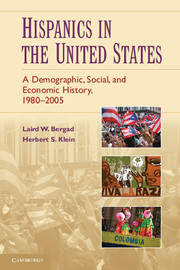Book contents
- Frontmatter
- Contents
- List of Graphs, Tables, and Maps
- Introduction
- 1 Immigration to the United States to 1980
- 2 The Hispanic Population to 1980
- 3 Population Growth and Dispersion, 1980–2005
- 4 The Demography of the Hispanic Population
- 5 Wealth and Poverty
- 6 Educational Attainment
- 7 Citizenship, the Latino Electorate, and Voter Participation
- 8 Occupational Structures, Employment, and Unemployment
- 9 English Language Abilities and Domestic Usage
- 10 Hispanic Business Ownership
- 11 Race
- 12 Endogamous and Exogamous Marriage Patterns among Latino Household Heads
- 13 Conclusion
- Bibliography
- Index
- References
8 - Occupational Structures, Employment, and Unemployment
Published online by Cambridge University Press: 05 June 2012
- Frontmatter
- Contents
- List of Graphs, Tables, and Maps
- Introduction
- 1 Immigration to the United States to 1980
- 2 The Hispanic Population to 1980
- 3 Population Growth and Dispersion, 1980–2005
- 4 The Demography of the Hispanic Population
- 5 Wealth and Poverty
- 6 Educational Attainment
- 7 Citizenship, the Latino Electorate, and Voter Participation
- 8 Occupational Structures, Employment, and Unemployment
- 9 English Language Abilities and Domestic Usage
- 10 Hispanic Business Ownership
- 11 Race
- 12 Endogamous and Exogamous Marriage Patterns among Latino Household Heads
- 13 Conclusion
- Bibliography
- Index
- References
Summary
Occupational Structures
The occupational structure of the Latino workforce was fundamentally different from the other racial and ethnic groups in the United States in that Latinos were far less likely to occupy higher-status and salaried management and professional positions than non-Hispanic whites and blacks and Asians. This was closely connected to the surge in the migration of lesser-educated persons after 1980 and the resulting lower educational attainment levels found among Latinos. In 2005 only 16.7% of all Hispanics worked in these higher-income earning professions compared with 35.4% of employed non-Hispanic whites, 23.6% of non-Hispanic blacks, and 44% of Asians. Yet, nearly 46% of the Hispanic labor force was employed in service, sales, and office occupations, and this was not too different from the other racial/ethnic groups, each of which had over 40% of their respective employed populations working in these same professions.
A major divergence was found in construction trades where there was a higher concentration of Latinos. Slightly over 15% of employed Hispanics labored in construction-related occupations compared with 9.6% of non-Hispanic whites, 6.5% of non-Hispanic blacks, and 3.6% of Asians. When construction and production occupations are examined together, the contrasts with the other racial/ethnic groups are more extreme. Just over a third of all employed Latinos worked in these two categories compared with 21.5% of non-Hispanic whites, 23.5% of non-Hispanic blacks, and only 14.7% of Asians who were employed (see Graph 8.1).
- Type
- Chapter
- Information
- Hispanics in the United StatesA Demographic, Social, and Economic History, 1980–2005, pp. 276 - 319Publisher: Cambridge University PressPrint publication year: 2010



